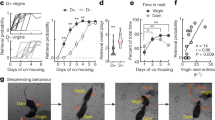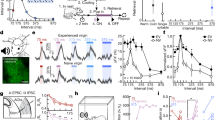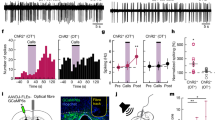Abstract
Odor-shock conditioning produces either olfactory preference or aversion in preweanling (12–15 days old) rats, depending on the context. In the mother's absence, odor-shock conditioning produces amygdala activation and learned odor avoidance. With maternal presence, this same conditioning yields an odor preference without amygdala activation. Maternal presence acts through modulation of pup corticosterone and corticosterone's regulation of amygdala activity. Over-riding maternal suppression of corticosterone through intra-amygdala corticosterone infusions permits fear conditioning and amygdala activation.
This is a preview of subscription content, access via your institution
Access options
Subscribe to this journal
Receive 12 print issues and online access
$209.00 per year
only $17.42 per issue
Buy this article
- Purchase on Springer Link
- Instant access to full article PDF
Prices may be subject to local taxes which are calculated during checkout



Similar content being viewed by others
References
Teicher, M.H. et al. Neurosci. Biobehav. Rev. 27, 33–44 (2003).
Heim, C. & Nemeroff, C.B. Biol. Psychiatry 49, 1023–1039 (2001).
Pollak, S.D. & Kistler, D.J. Proc. Natl. Acad. Sci. USA 99, 9072–9076 (2002).
Sullivan, R.M. Ann. NY Acad. Sci. 1008, 122–131 (2003).
Maestripieri, D., Lindell, S.G., Ayala, A., Gold, P.W. & Higley, J.D. Neurosci. Biobehav. Rev. 29, 51–57 (2005).
Haroutunian, V. & Campbell, B.A. Science 205, 927–929 (1979).
Camp, L.L. & Rudy, J.W. Dev. Psychobiol. 21, 25–42 (1988).
Sullivan, R.M. et al. Nature 407, 38–39 (2000).
Barr, G.A. NIDA Res. Monogr. 158, 172–201 (1995).
Roth, T.L. & Sullivan, R.M. Biol. Psychiatry 57, 823–831 (2005).
Levine, S. Eur. J. Pharmacol. 405, 149–160 (2000).
Moriceau, S., Wilson, D.A., Levine, S. & Sullivan, R.M. J. Neurosci. 26, 6737–6748.
Moriceau, S. & Sullivan, R.M. Behav. Neurosci. 118, 274–281 (2004).
Stanton, M.E. & Levine, S. Dev. Psychobiol. 23, 411–426 (1990).
Fanselow, M.S. & LeDoux, J.E. Neuron 23, 229–232 (1999).
Acknowledgements
Supported by grants to R.M.S. from the US National Institute of Child Health and Human Development (HD33402), the US National Science Foundation (IOB0544406) and the Oklahoma Center for the Advancement of Science and Technology; and by funds to S.M. from the University of Oklahoma.
Author information
Authors and Affiliations
Corresponding author
Ethics declarations
Competing interests
The authors declare no competing financial interests.
Supplementary information
Supplementary Fig. 1
Cortical, medial and central amygdala nuclei activity during ordor-shock acquisition was assessed by relative C14 2-DG uptake with and without maternal presence. (PDF 1519 kb)
Supplementary Fig. 2
(Top) Pseudocolor autoradiograph of C14 2-DG uptake in a 12 day old during odor-shock training overlayed on a dark-field image of the same section stained with cresyl violet. (PDF 5285 kb)
Supplementary Fig. 3
Locations of cannula tips (solid circles) in rats used for muscimol infusion into the amygdala. (PDF 10902 kb)
Supplementary Fig. 4
Corticosterone diffusion within the amygdala. (PDF 14908 kb)
Rights and permissions
About this article
Cite this article
Moriceau, S., Sullivan, R. Maternal presence serves as a switch between learning fear and attraction in infancy. Nat Neurosci 9, 1004–1006 (2006). https://doi.org/10.1038/nn1733
Received:
Accepted:
Published:
Issue Date:
DOI: https://doi.org/10.1038/nn1733
This article is cited by
-
Association between maltreatment, hair cortisol concentration, positive parent–child interaction, and psychosocial outcomes in Chinese preschool children
European Child & Adolescent Psychiatry (2024)
-
The influence of being left behind on fear acquisition and academic performance—a study of left-behind children
Current Psychology (2023)
-
Prelimbic proBDNF Facilitates Retrieval-Dependent Fear Memory Destabilization by Regulation of Synaptic and Neural Functions in Juvenile Rats
Molecular Neurobiology (2022)
-
Ontogeny of the Corticolimbic System and the Risk of Anxiety Disorders in Adolescence
Neuroscience and Behavioral Physiology (2022)
-
Mechanisms of neuroplasticity linking early adversity to depression: developmental considerations
Translational Psychiatry (2021)



